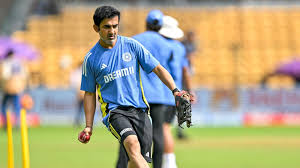In the wake of India’s recent 0-3 defeat in an ODI series, former cricketer Gautam Gambhir has been in the spotlight for challenging head coach Rahul Dravid’s pitch strategy. The series, marked by underwhelming performances, has ignited debate over whether India’s approach to pitch selection and conditions was a significant factor in their downfall. Dravid’s philosophy, which has often emphasized the importance of adapting to challenging pitches to prepare players for tougher international tournaments, seems to have clashed with Gambhir’s perspective.
Gambhir, known for his straightforward and sometimes outspoken nature, did not hold back his critique. According to reports, he pointed out that focusing on pitches that excessively favor bowlers or present unpredictable conditions can backfire, especially when the team needs to rely on consistent scoring. He emphasized that instead of solely preparing on tough pitches, there should be a balance that allows batters to build confidence through match practice on more balanced surfaces. This disagreement hints at a larger issue within the team’s strategic framework.
Dravid’s approach stems from his extensive experience as a player and coach, having been known for his resilience and adaptability on difficult pitches throughout his career. His logic is that by challenging players in training and preparatory matches, they develop the mental toughness required for high-stakes situations. However, this pitch-first strategy has drawn mixed reactions, particularly after this series where India’s batting lineup faltered consistently.
Gambhir’s argument brings an essential counterpoint: while it’s important to prepare for difficult conditions, matches should also allow for developing rhythm and confidence. In this series, the Indian top order looked unsettled and lacked fluency, leading critics to question if they were over-preparing for worst-case scenarios rather than actual match conditions.
The debate is emblematic of a broader question in cricket: How should teams prepare for international tournaments? Should they train on pitches that simulate the most difficult playing environments, or should there be a blend of conditions that simulate match realities? While Gambhir’s comments may appear critical, they highlight a concern that many fans and analysts share — the need for a strategic approach that ensures players are match-ready in all scenarios.
Dravid’s defenders argue that tough pitch training has long-term benefits, citing the upcoming ICC events where surfaces could vary significantly. Yet, Gambhir’s remarks reflect the urgent need to re-evaluate strategies after a steep defeat like this one. India’s next steps will be closely watched as they seek to bounce back, balancing preparation, player morale, and adaptability.
Ultimately, this loss has triggered a crucial dialogue in Indian cricket on the best practices for preparing teams for success at the highest level. Whether Gambhir’s observations will lead to a shift in the team’s strategies remains to be seen, but the debate underscores the continuous evolution in how teams gear up for international cricket.
#GambhirVsDravid #PitchStrategy #IndianCricketDebate #TeamIndia #ODILoss


